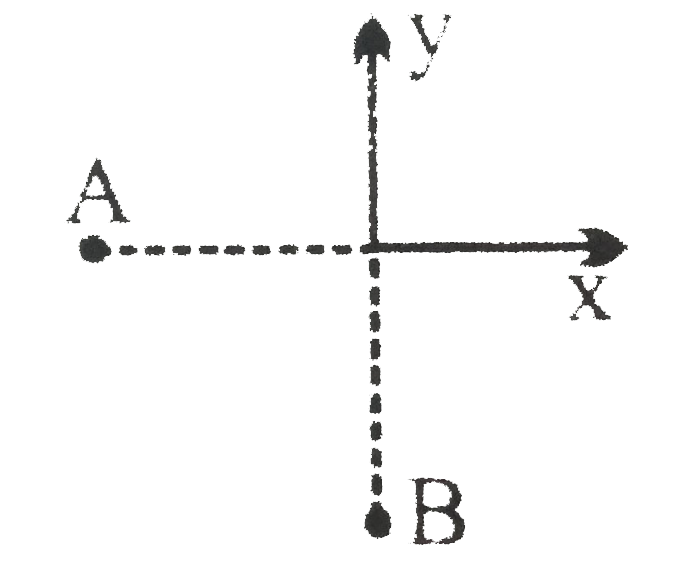Two particles A and B are moving in XY plane. Particle A moves along a line with equation y=x while B moves along X axis such that their X coordinates are always equal. If B moves with a uniform speed 3 m/s the speed of A is
3m/s
13m/s
3√2m/s
3√2m/s
The correct Answer is:C
To solve the problem, we need to find the speed of particle A given that particle B moves with a uniform speed of 3 m/s along the X-axis, and both particles have equal X-coordinates at all times.
1. Understanding the Motion of Particle A and B:
- Particle A moves along the line defined by the equation y=x.
- Particle B moves along the X-axis, and their X-coordinates are always equal.
2. Identifying the Relationship Between the Speeds:
- Since the X-coordinates of both particles are equal, the horizontal component of the velocity of particle A must be equal to the velocity of particle B.
- The speed of particle B is given as vB=3m/s.
3. Finding the Speed of Particle A:
- The speed of particle A can be represented as vA.
- The direction of particle A's motion is along the line y=x, which makes an angle of 45∘ with the X-axis.
- The horizontal component of the velocity of particle A can be expressed as:
vAx=vAcos(45∘)
- Since cos(45∘)=1√2, we can write:
vAx=vA⋅1√2
4. Setting Up the Equation:
- Since the horizontal velocities must be equal:
vAx=vB
- Substituting the known values:
vA⋅1√2=3
5. Solving for vA:
- Rearranging the equation gives:
vA=3√2
6. Calculating the Numerical Value:
- To find the numerical value of vA:
vA≈3×1.414≈4.242m/s
Final Answer:
The speed of particle A is 3√2m/s or approximately 4.24m/s.
---
- Particle A moves along the line defined by the equation y=x.
- Particle B moves along the X-axis, and their X-coordinates are always equal.
- Since the X-coordinates of both particles are equal, the horizontal component of the velocity of particle A must be equal to the velocity of particle B.
- The speed of particle B is given as vB=3m/s.
- The speed of particle A can be represented as vA.
- The direction of particle A's motion is along the line y=x, which makes an angle of 45∘ with the X-axis.
- The horizontal component of the velocity of particle A can be expressed as:
vAx=vAcos(45∘)
- Since cos(45∘)=1√2, we can write:
vAx=vA⋅1√2
- Since the horizontal velocities must be equal:
vAx=vB
- Substituting the known values:
vA⋅1√2=3
- Rearranging the equation gives:
vA=3√2
- To find the numerical value of vA:
vA≈3×1.414≈4.242m/s
The speed of particle A is 3√2m/s or approximately 4.24m/s.
Topper's Solved these Questions
- BOOK - RESONANCE ENGLISHCHAPTER - DAILY PRACTICE PROBLEMEXERCISE - DPP No.579videos
DAILY PRACTICE PROBLEM
- BOOK - RESONANCE ENGLISHCHAPTER - DAILY PRACTICE PROBLEMEXERCISE - DPP No.5820videos
DAILY PRACTICE PROBLEM
- BOOK - RESONANCE ENGLISHCHAPTER - DAILY PRACTICE PROBLEMEXERCISE - DPP No.559videos
DAILY PRACTICE PROBLEM
- BOOK - RESONANCE ENGLISHCHAPTER - CURRENT ELECTRICITYEXERCISE - High Level Problems (HIP)19videos
CURRENT ELECTRICITY
- BOOK - RESONANCE ENGLISHCHAPTER - ELECTRO MAGNETIC WAVESEXERCISE - Exercise 327videos
ELECTRO MAGNETIC WAVES
Similar Questions
If a particle is moving along straight line with increasing speed, then
View Solutionx-t equation of a particle moving along x-axis is given as
x=A+A(1−cosωt)View SolutionParticles A and B are moving with constant velocities along x and y axis respectively, the graph of separation between them with time is
 View Solution
View SolutionA particle moves along the straight line y=3x+5. Which coordinate changes at faster rate?
View SolutionA particle moves along x-axis with speed 6m/s for the first half distance of a journey and the second half distance with a speed 3m/s. The average speed in the total journey is
View SolutionA particle moves along the cirve x2+4=y. The points on the curve at which the y coordinates changes twice as fast as the x coordinate, is
View SolutionA particle moves along x-axis according to relation x=1+2sinωt. The amplitude of S.H.M. is
View SolutionTwo particles A and B are situated at point (60,0) at t=0. The particle A move on a circle given by X2+Y2=3600 and with a speed 6πm/s, while B moves with a constant velocity.
Find the velocity of B so that the collision takes places between A and B at point (60,0).View SolutionTwo particles A and B are moving along x-axis. Their x-coordinate versus time graphs are as shown below

(a) Find the time when the particles start their journey and the x-coordinate at that time.
(b) Find velocities of the two particles.
(c) When and where the particles strike with each other.View SolutionA particle moves along the x-axis according to the equation x=asinωt+bcosωt. The motion is simple harmonic with
View Solution

